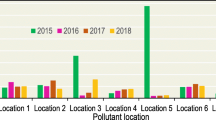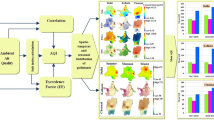Abstract
In the present study, air pollution monitoring was carried out in Chennai city continuously for more than 3 decades from 1978 to 2016 and air quality trends are established for planning mitigation measures. An extensive air pollution monitoring network consisting of 19 sampling locations covering traffic corridors and intersections, residential, commercial and industrial areas was operated to monitor dust and gaseous pollutants, toxic trace metals, polycyclic aromatic hydrocarbons (PAHs) and other criteria pollutants. Comprehensive emission inventory indicated contribution of pollution load is mainly from transport (80%) followed by domestic (13%), industry (4%), commercial activities (2%) and power back generators (1%). The air pollutant concentrations were high during day time in winter season at traffic corridors, intersections and industrial areas. The monitoring data indicated PM10, PM2.5 and PAHs concentrations were exceeding the limits due to vehicular emissions, road condition (paved and unpaved), construction, industrial and commercial activities. Carbon monoxide and hydrocarbon concentrations were high during traffic peak hours and near road corridors where traffic congestion is high. GM, ATDL and ISCST3 models were employed to assess the contribution of air pollutants from transport, domestic and industry sector, respectively. Performance evaluation of models was also carried out by comparing monitored and model-predicted concentration to assess model prediction accuracy.






Similar content being viewed by others
References
Abidin EZ, Semple S, Rasdi I, Ismail SNS, Ayres JG (2014) The relationship between air pollution and asthma in Malaysian school children. Air Qual Atmos Health 7:421–432
American Thoracic Society (1991) Lung function testing: selection of reference values and interpretative strategies. Am Rev Respir Dis 140:1202–1209
Bhanarkar AD, Goyal SK, Sivacoumar R, Chalapathi Rao CV (2005) Assessment of contribution of SO2 and NO2 from different sources in Jamshedpur region, India. J Atmos Environ 39:7745–7760
BIS (1999a) Reaffirmed 2010. Indian standard methods for measurement of air pollution, suspended particulate matter (IS 5182 Part 4). Bureau of Indian Standards, New Delhi
BIS (1999b) Indian standard methods for measurement of air pollution, carbon monoxide (IS 5182 Part 10). Bureau of Indian Standards, New Delhi
BIS (2001) Reaffirmed 2012. Indian standard methods for measurement of air pollution, sulphur dioxide (IS 5182 Part 2). Bureau of Indian Standards, New Delhi
BIS (2004a) Reaffirmed 2009. Indian standard methods for measurement of air pollution, Lead (IS5182 Part 22). Bureau of Indian Standards, New Delhi
BIS (2004b) Indian standard methods for measurement of air pollution, poly nuclear aromatic hydrocarbons (PAHs) in air particulate matter (IS 5182 Part 12). Bureau of Indian Standards, New Delhi
BIS (2006a) Indian standard methods for measurement of air pollution, respirable suspended particulate matter (PM10), cyclonic flow technique (IS 5182 Part 23). Bureau of Indian Standards, New Delhi
BIS (2006b) Indian standard methods for measurement of air pollution, oxides of nitrogen (IS 5182 Part 6). Bureau of Indian Standards, New Delhi
BIS (2006c) Indian standard methods for measurement of air pollution, benzene, toluene and xylene (BTX) (IS 5182 Part 11). Bureau of Indian Standards, New Delhi
Bostrom CE, Gerde P, Hanberg A, Jenstrom B, Johansson C, Kyrklund T, Rannug A, Tornqvis TM, Victorin K, Westerholm R (2002) Cancer risk assessment, indicators, and guidelines for polycyclic aromatic hydrocarbons in the ambient air. Environ Health Perspect 110:451–488
Briggs GA (1973) Diffusion estimation for small emissions. Air Resources Atmospheric Turbulence and Diffusion Laboratory, Environmental Research Laboratory, NOAA, 1973 Annual Rep. ATDL-79, 59 pp
Buonanno G, Marks GB, Morawska L (2013) Health effects of daily airborne particle dose in children: direct association between personal dose and respiratory health effects. Environ Pollut 180:246–250
Chennai metropolitan development authority (CMDA) (2016) Master plan for Chennai metropolitan area, 2026. Chennai, India
CPCB (2009) National ambient air quality standards (NAAQS). Central pollution Control Board Notification, New Delhi
General Motors Corp (1985) Vehicle in-use emissions and vehicle emissions modeling. General Motors Corp, Warren
Gu JX, Du SY, Han DW, Hou LJ, Yi J, Xu J, Liu GH, Han B, Yang GW, Bai ZP (2014) Major chemical compositions, possible sources, and mass closure analysis of PM2.5 in Jinan, China. Air Qual Atmos Health 7:251–262
Hong HS, Yin HLG, Wang XH, Ye CX (2007) Seasonal variation of PM10-bound PAHs in the atmosphere of Xiamen, China. Atmos Res 85:429–441
Karar K, Gupta AK (2006) Seasonal variations and chemical characterization of ambient PM10 at residential and industrial sites of an urban region of Kolkata (Calcutta), India. Atmos Res 81:36–53
Kumar A, Patil RS, Kumar AD, Kumar R (2016) Comparison of predicted vehicular pollution concentration with air quality standards for different time periods. Clean Technol Environ Policy 18(7):2293–2303
Liao X, Tu H, Maddock JE, Fan S, Lan GL, Wu YY, Yuan ZK, Lu YN (2015) Residents perception of air quality, pollution sources, and air pollution control in Nanchang, China. Atmos Pollut Res 5:835–841
Marr LC, Grogan HW, Molina LT, Molina MJ (2004) Vehicle traffic as a source of polycyclic aromatic hydrocarbons exposure in the Mexico City Metropolitan Area. Environ Sci Technol 38:2584–2592
Mathew J, Goyal R, Taneja KK, Arora N (2015) Air pollution and respiratory health of school children in industrial, commercial and residential areas of Delhi. Air Qual Atmos Health 8:421–427
NEERI (2011) Ambient air quality status for six cities of India. Central Pollution Control Board, New Delhi
Panepinto D, Brizio E, Genon G (2014) Atmospheric pollutants and air quality effects: limitation costs and environmental advantages (a cost–benefit approach). Clean Technol Environ Policy 16:1805–1813
Ravindra K, Mor S, Ameena, Kamyotra JS, Kaushik CP (2003) Variation in spatial pattern of criteria air pollutants before and during initial rain of monsoon. Environ Monit Assess 87:145–153
Sharma H, Jain VK, Khan ZH (2007) Characterization and source identification of PAH in the urban environment of Delhi. Chemosphere 66:302–310
Sivacoumar R, Thanasekaran K (1999) Line source model for vehicular pollution prediction near roadways and model evaluation through statistical analysis. Environ Pollut 104:389–395
Sivacoumar R, Thanasekaran K (2000) Emission factors and emission estimation for indian vehicles a case study. IE(I) J 81:28–31
Sivacoumar R, Bhanarkar AD, Goyal SK, Gadkari SK (1999) Air quality prediction and model performance evaluation. Indian J Environ Manag 26:163–167
Sivacoumar R, Jayabalou R, Swarnalatha S, Balakrishnan K (2006) Particulate matter from stone crushing industry: distribution and health effects. J Environ Eng 132(3):405–414
United States-Agency for Toxic Substances and Disease Registry, US-ATSDR (1995) Toxicology profile for polycyclic aromatic hydrocarbons. US Department of Health and Human Services, Atlanta
USEPA (1995) User’s guide for the industrial source complex (ISC3) dispersion models. EPA-454/B-95-003a, vol 1 (user instructions). US Environmental Protection Agency, Research Triangle Park
Acknowledgements
The authors are grateful to the Director, National Environmental Engineering Research Institute, Nagpur, India, for the facilities made available for this work. They are also grateful to the Central Pollution Control Board (CPCB) (Grant No. G-1-2121), New Delhi, for sponsoring the project. They are also thankful to the Head, KRC, CSIR-NEERI, for checking the manuscript through iThenticate (anti-plagiarism software) and allotting manuscript no: CSIR-NEERI/KRC/2017/Jan/CZL/2 on January 06, 2017.
Author information
Authors and Affiliations
Corresponding author
Additional information
Editorial responsibility: Necip Atar.
Electronic supplementary material
Below is the link to the electronic supplementary material.
Rights and permissions
About this article
Cite this article
Sivacoumar, R., Jayabalou, R. Assessment of source contribution to ambient air quality through comprehensive emission inventory, long-term monitoring and deterministic modeling. Int. J. Environ. Sci. Technol. 16, 2765–2782 (2019). https://doi.org/10.1007/s13762-018-2026-y
Received:
Revised:
Accepted:
Published:
Issue Date:
DOI: https://doi.org/10.1007/s13762-018-2026-y




